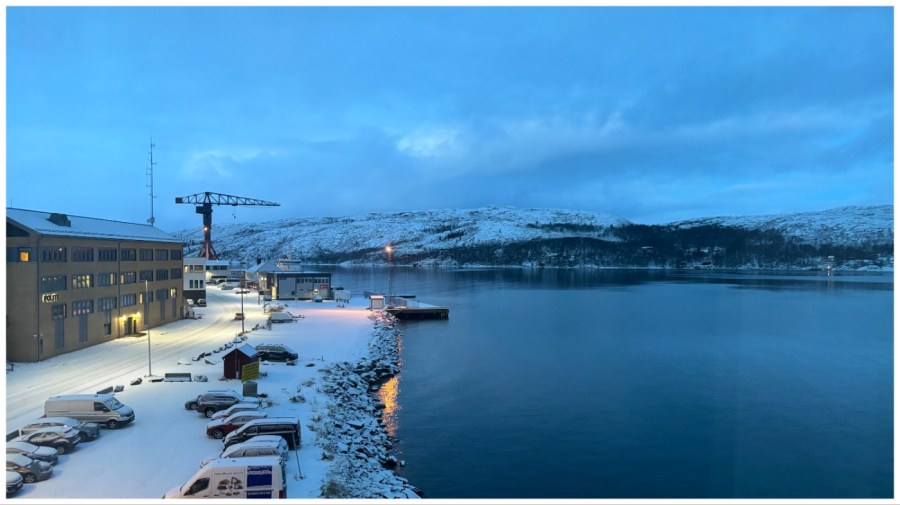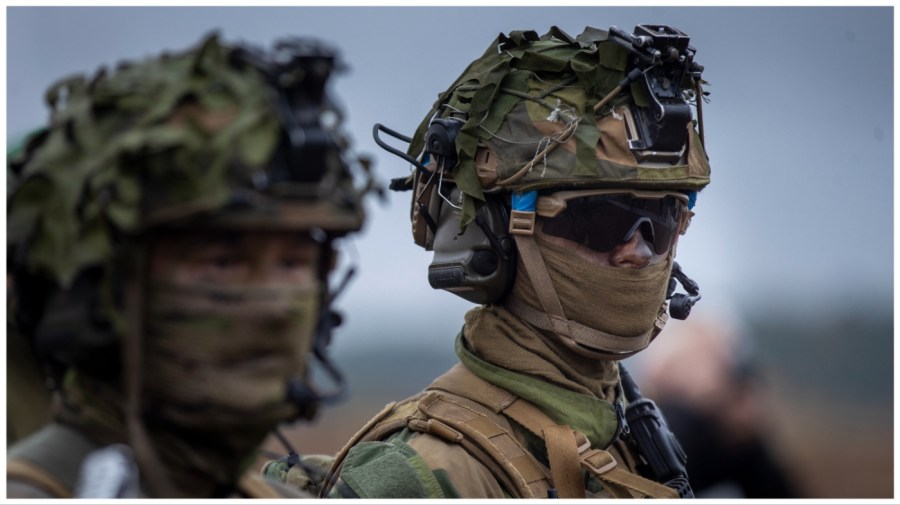On NATO’s Arctic front line, watching Russia’s nuclear threat
KIRKENES, Norway — The Russian city of Nikel is a ghost town.
Norwegian border guards, from their observation tower a few miles away, peer over into the former factory city, which has seen its decline accelerated by Russia’s war on Ukraine.
They are the eyes and ears of NATO’s northern front line, across from Russia’s naval nuclear weapons base on the Kola peninsula, hundreds of miles above the Arctic Circle.
“This is where Norway starts, this is where NATO starts,” said Lt. Col. Michael Rozmara, a commander in Norway’s border guards, speaking at the Garrison of Sør-Varanger in this tiny Arctic city at the northeastern edge of the Scandinavian state.
Norway’s border force is made of ruddy-cheeked, teenage conscripts — men and women — trained to survive the punishing physical and mental strain of the freezing, snow-covered and dark environs, where the sun barely crosses the horizon in the hardest days of the winter.
A small team of conscripts lives at the observation tower overlooking Nikel for stretches of three weeks, watching and patrolling a border they describe as having stayed relatively quiet since Russia launched its full-scale invasion of Ukraine in February 2022.
That’s despite plenty of saber-rattling from Russian President Vladimir Putin, who has repeatedly suggested red lines in his war against Ukraine and has often referenced the country’s massive nuclear stockpile.
This area also garnered global attention in January, when a fighter with the Russian private mercenary group Wagner slipped past Russia’s border patrols, seeking asylum in Norway.
But such a case was an exception, with Russia exercising tight security on its side of the border and against deserters.
Norway has been transformed by Russia’s war in Ukraine, shifting public opinion about relations with Russia and its potential threat and leading governments to boost security spending.
A founding member of NATO in 1949, Norway is undergoing a massive reworking of its security posture after what officials acknowledge was years of complacency toward external threats and naivete about Moscow.
“It might be hard to understand how deep the peace has been in Norway … we literally felt that nothing could go wrong for generations,” Norway Deputy Minister of Defense Anne Marie Aanerud said in a briefing with a U.S. delegation of government, congressional staff and think tank representatives in early November.
“And then all of a sudden Ukraine, and the invasion happened, and I think that opened up this box of new possibilities that most Norwegians never thought was possible, that altered security perception in the population.”
However, Norway had already encountered Russia’s “gray zone” tactics close to home.
Perhaps the most high-profile harassment was a 2015 border crisis — when Russia facilitated an influx of Middle Eastern migrants to the border with Norway. That came after Oslo joined with other countries, including the U.S., in condemning Moscow’s invasion of Ukraine’s east and annexation of the Crimean peninsula.
Norwegian security officials also describe Russian electronic jamming and careless trolling on the seabed floor that damages internet cables and energy pipes.
There have also been manufactured diplomatic crises. Last month, the Russian Foreign Ministry summoned the Norwegian ambassador to Moscow in protest after the Russian console picked a fight with the mayor of Kirkenes over a Soviet monument in the tiny city.
Norway has historically sought to manage a careful balance with Russia, with Oslo holding back its military activities on the border as a gesture of reassurance that NATO’s Arctic member could never be used as a launchpad of attack.
Lt. Col. Rozmara said the Norwegian troops in the area are equipped with Javelins, but Oslo has held back from dispatching heavily armored vehicles to the border.
But Russia’s full-scale invasion of Ukraine was a watershed moment, and officials say they now recognize the need to scale up their national defense. But politicians and the public are still cautious about becoming too militarized.

For the U.S., Norway is a critical defense partner, with its vast coast facing the Norwegian and Barents Sea and its shared northern border with Russia.
Oslo can raise early alarm about menacing Russian activity in the Arctic — keeping an eye on Russia’s nuclear-armed Northern Fleet, watching the training of its forces from their base in the Russian city of Murmansk and maintaining direct, if strained, lines of communication between the Russian military and diplomatic officials.
Norway also brings the benefits of an estimated $1.4 trillion sovereign wealth fund bloated by oil and gas revenues, as well as its potential as a critical mineral supplier.
And it’s been a staunch supporter of Ukraine on the ground, earlier this year committing $7 billion over five years — half to military support and half to humanitarian aid. Norway is one of a few countries that has pledged F-16 fighter jets to Ukraine and offered training for its pilots.
American officials praised Oslo’s support package at the time, and they hope it will encourage other countries to similarly make long-term commitments.
In Washington, the Biden administration is now fighting an uphill battle to move through Congress a one-year military and economic supplemental package, which includes $60 billion for Ukraine.
And while Norway for 74 years held the distinction of being NATO’s only northern land border with Russia, Finland’s accession to the alliance — and Sweden’s upcoming membership — has changed the paradigm.
Russia is in a weaker position compared to an expanded NATO, but shoring up security cooperation between the Scandinavian countries is still a major undertaking. Especially as Moscow looks for opportunities to probe gaps and sow chaos.
“We see a Russia that is of course conventionally weakened because of great losses in Ukraine. But those losses are mainly on the land side. Their maritime and air capabilities are intact and so are their strategic capabilities,” Aanerud, the deputy defense minister, said.
“We have repeatedly seen very dangerous nuclear rhetoric coming out of the Kremlin over the past one and a half years, which is a symptom that a conventionally weakened Russia is leaning more heavily on its strategic capabilities. And some of those strategic capabilities are situated right next to the Norwegian border on the Kola peninsula.”
Between August and September, Russia carried out a provocative naval exercise that Aanerud described as practice for isolating the Scandinavian peninsula.
Norway will answer Russia with a massive military exercise in March called “Nordic Response,” taking place across land, air and sea in Norway, Sweden and Finland, with 20,000 troops from 14 countries.
The exercise is aimed at gaming out critical questions of how the Scandinavian countries will work together in the event of a conflict. How will they take out Russian installations? How will they attack Russian forces? And how deep will these NATO members be able to strike into Russia?
But even while Norway bolsters its military, it isn’t giving up on a careful detente with Russia — so-called self-imposed Norwegian restraint — creating some societal tension between those with a sentimental sense of safety, and a national security establishment anxious to bolster its defenses.
The policy of restraint, developed as part of Norway’s joining of NATO, is meant to reassure Russia that the country could never be used as a base of attack against the then-Soviet Union.
Some of the practical aspects of that policy include that Norway does not allow foreign forces to establish military bases in the country, does not hold nuclear weapons, avoids heavy militarization of its border, and imposes restrictions on its surveillance of Russia.
“This is a quite vivid part of the political debate in Norway,” said Kari Elisabeth Kaski, a Norwegian parliamentarian from the Socialist Left Party, originally from Kirkenes and a substitute member of the Delegation to the NATO Parliamentary Assembly.
“I think that we should see how that plays out in NATO. But I think it’s important for Norway to still be a voice for trying to have the conflict as low as possible in this part of NATO, and still play that role that we have been, the eyes and the ears, but also to try and keep the conflict low.”

On the other side of the debate, Janne Haaland Matlary, professor of International Politics at the University of Oslo, described the Norwegian government’s position as “so timid,” and based on a perception that the U.S. will be there to defend Norway in a crisis.
“Cooperation will force us to be less careful,” she said, referring to the integration with Finland and Sweden. “Of course we want low tension in the high north — which makes eminent sense at times of low tension — but not, perhaps, if you want to establish a new normal. And the Russians have established a new abnormal.”
Back in Kirkenes, Norway’s armed forces are acutely aware of how quickly things can change.
One 20-something lance corporal who is nearing the end of his tour in Kirkenes, was one month into his service when his commander spread the news on Feb. 24 that Russia invaded, and a new ground war in Europe had started.
“The girls were crying, the boys were crying, we didn’t know who was at war,” he said, asking to speak anonymously. It took a couple hours for his commander to clarify that Russia had invaded Ukraine, and Norway was still at peace, for the time being.
But that experience left a deep impression on the Nordic soldier, who recounted the story to the group stationed at the border tower. I remark to the group that war is a terrible thing.
“War is hell,” one of the conscripts responds.
The writer was a participant on a study-tour of Norway organized by the Atlantic Council, a Washington-based think-tank, with funding provided by the Norwegian Ministry of Defense.
Copyright 2023 Nexstar Media Inc. All rights reserved. This material may not be published, broadcast, rewritten, or redistributed.

